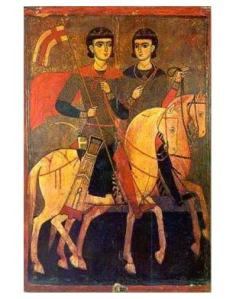
“Sergius & Bacchus: Lovers & Martyrs?"
The recognition of saints is an important part of Catholic history and tradition. Growing up in a Catholic school, I was frequently urged to read the lives of the saints, of which our small school library had a copious supply, for my spiritual well-being.
Many adult Catholics retain a special affection, even devotion, to particular favoured saints. For some of us, this makes us a little uncomfortable. Partly, this is because the more demonstrative forms of veneration may come dangerously close to the Protestant perception of a cult of idolatrous 'worship' of the saints; for others , the problem is simply that of the remoteness of most of the saints: remote in time, overwhelmingly limited in geography to Europe, and particularly certain regions of Europe. There is also the problem that the recognised saints were, if not ordained clergy and religious sisters, at least celibate lay people - creating a perception that saintliness is reserved to the asexual, even unsexed, among us, leading lives devoid of intimate personal relationships. (This creates the further problem of a simplistic association of healthy emotional and sexual lives with 'sin'.) Pope John Paul II, during his long pontificate, set about creating an unprecedented number of new saints for the modern age, deliberately seeking to undo this sense of remoteness. We now have many more saints, and beatified saints-in-waiting, from recent history and from beyond Europe. There were even reports that he was actively looking for a suitable married couple for elevation, to counter the perception that sainthood applied only to the celibate. But we in the LGBT community remain excluded - or think we are. "How great it would be", we think, if we too could have saints of our own. It is in this spirit that a number of modern scholars (most notably John Boswell, followed by others) have dug into history and produced evidence of recognised 'gay saints' in church history. The LGBT Catholic Handbook has an extensive listing of the best known of these. Is it realistic to think of these as 'gay saints'? Is it helpful? I suggest that the answer to the first question is probably "No", at least not as narrowly defined. But to the second question, I would answer, most certainly, "Yes, helpful indeed, if interpreted more broadly." The problem with the term, narrowly interpreted is that it is so fluid, imprecise and anachronistic. For St Jerome and St Alcuin, where the status of sainthood is uncontested, there is a different problem. Although there is clear evidence that these two, and others, experienced strong, even intimate emotional relationships with other men, it is not absolutely agreed that these relationships were sexual. And so, it is argued, these men cannot be understood as 'gay'. (Others would suggest that the naysayers are deliberately ignoring the plain evidence infront of their eyes, but no matter, the dispute is plainly there. So where are the gay saints, narrowly defined? I do not know of any who unambiguously meet both criteria: agreed to be saints, agreed to be gay. Nevertheless, I don't think this is important. It is not only the canonised saints who are important: I was taught that we are all potentially saints, even if not recognised. The "communion of saints" includes many more than the limited number who have been publicly acknowledged. It is also of no consequence whether particular individuals expressed their emotional intimacy in genital acts to be considered in some snese 'gay'. (We do not require that other saints show evidence of genital activity with the opposite sex to be considered 'heterosexual'). By applying a looser, broader definition, then I suggest that there will be many 'gay saints' that have gone before us, and many who still live among us. This not to suggest that praying to them is likely to produce miracles in support of official canonisation - but it is important that we recognise and offer respect to role models in our history. It is in this spirit that I commend a closer examination of the many figures who have been suggested as supposed 'gay saints'.
No comments:
Post a Comment